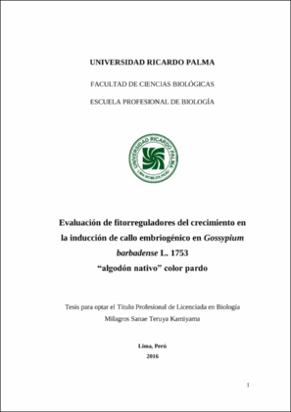| dc.contributor.advisor | Quiñones Aguilar, Mauro | |
| dc.contributor.author | Teruya Kamiyama, Milagros Sanae | |
| dc.date.accessioned | 2017-05-31T18:06:04Z | |
| dc.date.available | 2017-05-31T18:06:04Z | |
| dc.date.issued | 2016 | |
| dc.identifier.uri | https://hdl.handle.net/20.500.14138/921 | |
| dc.description.abstract | Gossypium barbadense L. “algodón nativo” es oriundo de la costa norte del Perú y se caracteriza por presentar fibras de colores naturales. La evaluación del efecto de diferentes concentraciones de fitorreguladores de crecimiento en la inducción de callo embriogénico se realizó en explantes de hipocotilo de G. barbadense L. “algodón nativo” color pardo, bajo dos condiciones lumínicas distintas. La desinfección de semillas se llevó a cabo utilizando NaOCl al 2.5% en distintos tiempos de exposición (5-20 min) para obtener plántulas in vitro. Para la iniciación y proliferación de callos, se introdujeron explantes de hipocotilo (con 5 réplicas) en medios Murashige-Skoog (MS) suplementados con diferentes concentraciones de ácido 2,4-diclorofenoxiacético (2,4-D), kinetina (Kin) y agua de coco. Los callos friables de mayor proliferación fueron transferidos a medios MS con distintas concentraciones de Kin, 2,4-D y ácido indol-3-butírico (IBA) para la inducción de callo embriogénico. Los cultivos fueron mantenidos en condiciones de fotoperiodo 16 h luz/ 8 h oscuridad y oscuridad continua. Se logró el 100% de desinfección de semillas en 10 min de exposición al desinfectante. En 85% a 100% de explantes de hipocotilo se obtuvo la formación de callo en todos los tratamientos de iniciación de callo incubados en ambas condiciones lumínicas durante 21 días. La mayor proliferación de callo friable se obtuvo en 82.5% de explantes cultivados en medio MS enriquecido con 0.1 mg/l de 2,4-D y 100 ml/l de agua de coco e incubados en fotoperiodo 16 h luz/ 8 h oscuridad. En los medios MS suplementados con distintas concentraciones de Kin, 2,4-D e IBA no se logró la inducción de callo embriogénico. Sin embargo, en el medio MS sin reguladores de crecimiento y en el suplementado con 0.05 mg/l de Kin y 0.3 mg/l de IBA, en fotoperiodo 16 h luz/ 8 h oscuridad, se inició la organogénesis radical.Gossypium barbadense L. “native cotton” is originally from the northern coast of Peru and is characterized by its naturally colored fibers. The evaluation of the effect of different concentrations of plant growth regulators on embryogenic callus induction was performed in hypocotyl explants of Gossypium barbadense L. “native cotton” brown, under two different lighting conditions. Seed disinfection was carried out using 2.5% NaOCl in different exposure times (5-20 min) in order to obtain in vitro plants. For initiation and proliferation of callus, hypocotyl explants (with 5 replicates) were placed in Murashige-Skoog (MS) medium supplemented with different concentrations of 2,4-Dichlorophenoxyacetic acid (2,4-D), kinetin (Kin) and coconut water. Friable calli with the highest proliferation were transferred to MS medium with different concentrations of Kin, 2,4-D and indole-3-butyric acid (IBA) for induction of embryogenic callus. The cultures were maintained under conditions of 16 h light/ 8 h dark photoperiod and continuous darkness. 100% of seed disinfection was achieved at 10 min of exposure to disinfectant. In 85% to 100% of hypocotyl explants, callus formation was obtained in all callus induction treatments, incubated in both lighting conditions during 21 days. The highest proliferation of friable callus was obtained in 82.5% of hypocotyl explants cultivated in MS medium enriched with 0.1 mg/l 2,4-D and 100 ml/l coconut water, in 16 h light/ 8 h dark photoperiod. In MS medium supplemented with different concentrations of Kin, 2,4-D and IBA, induction of embryogenic callus was not achieved. However, in MS medium without growth regulators and supplemented with 0.05 mg/l Kin and 0.3 mg/l IBA, in 16 h light/ 8 h dark photoperiod, root organogenesis was initiated. | es_ES |
| dc.description.sponsorship | Submitted by Wong Rafael (rafel_wl@hotmail.com) on 2017-05-31T18:06:04Z
No. of bitstreams: 1
Teruya_ms.pdf: 2723064 bytes, checksum: 3c9abeb7ad4fd11b6a7f202a203e904b (MD5) | es_ES |
| dc.description.sponsorship | Made available in DSpace on 2017-05-31T18:06:04Z (GMT). No. of bitstreams: 1
Teruya_ms.pdf: 2723064 bytes, checksum: 3c9abeb7ad4fd11b6a7f202a203e904b (MD5)
Previous issue date: 2016 | es_ES |
| dc.description.uri | Tesis | es_ES |
| dc.format | application/pdf | |
| dc.language.iso | spa | |
| dc.publisher | Universidad Ricardo Palma - URP | es_ES |
| dc.rights | info:eu-repo/semantics/openAccess | |
| dc.rights.uri | https://creativecommons.org/licenses/by-nc-nd/4.0/ | |
| dc.source | Repositorio Institucional - URP | es_ES |
| dc.subject | Fitorreguladores del crecimiento | es_ES |
| dc.subject | algodón nativo | es_ES |
| dc.subject | callo friable | es_ES |
| dc.subject | callo embriogénico | es_ES |
| dc.subject | Plant growth regulators | es_ES |
| dc.subject | native cotton | es_ES |
| dc.subject | friable callus | es_ES |
| dc.subject | embryogenic callus | es_ES |
| dc.title | “Evaluación de fitorreguladores del crecimiento en la inducción de callo embriogénico en Gossypium barbadense L. 1753 “algodón nativo” color pardo.“ | es_ES |
| dc.type | info:eu-repo/semantics/bachelorThesis | |
| thesis.degree.discipline | Biología | es_ES |
| thesis.degree.grantor | Universidad Ricardo Palma. Facultad de Ciencias Biológicas. Escuela Profesional de Biología | es_ES |
| thesis.degree.level | Título Profesional | es_ES |
| thesis.degree.name | Licenciada en Biología | es_ES |
| dc.publisher.country | PE | es_ES |
| renati.type | https://purl.org/pe-repo/renati/type#tesis | |
| renati.level | https://purl.org/pe-repo/renati/nivel#tituloProfesional | |
| renati.discipline | 511206 | |
| dc.type.version | info:eu-repo/semantics/publishedVersion | |


